Planning your own trip? Prepare for your trip
Use Rough Guides' trusted partners for great rates
Book your individual trip, stress-free with local travel experts
Plan your tailor-made trip with a local expert
Book securely with money-back guarantee
Travel stress-free with local assistance and 24/7 support
Matt Mickiewicz
Trip Provider took us far off the beaten tourist path in Bali, and arranged a unique and very special experience far away from the tourist crowds that we w...
Read all reviews ⤍Java is Indonesia’s heartland. The archipelago's most densely-populated island is unlike any other. Home to some of the country's biggest cities, plus 30 active volcanoes that rise magnificently amid the rice fields, the interior houses Java's remaining forests, now limited to its 12 national parks. They protect some of the Earth’s rarest creatures. Jakarta, the nation’s bustling capital, is here – a world of glittering skyscrapers, pricey shopping malls and bumper-to-bumper traffic – plus Surabaya, Indonesia’s second-largest city. Then, on the north coast, is Semarang with its intriguing mix of descendants of traders from afar.
At the heart of Java is Yogyakarta, where painters, gamelan musicians, batik artists and dancers study and perform. Its rich courtly culture, refined manners, elevated language and proud traditions make it the traditional wellspring of Javanese culture. Outside its realm are Borobudur and Prambanan and countless smaller temples, remnants of glorious past kingdoms.
Trekking, climbing, birdwatching and wildlife-spotting at Gunung Bromo, Ujung Kulon and Gunung Merapi attract adventurers and naturalists. Two parks – Kepulauan Seribu and Karimunjawa – are marine preserves, luring water-lovers to their shores; Alas Purwo has some of the best surfing this side of Hawaii.
Around half of Java’s inhabitants still live in rural areas, with many still making a living as farmers or fishermen. For 1,000 years, from the time of the great Hindu-Buddhist empires up to the early 1800s, Java’s population of 3.5 million remained relatively stable. Wet-rice cultivation was the basis of civilisation, and as long as the population was small, farmers produced vast surpluses. Then in the 19th century, a forced-labour cultivation system instigated by the Dutch to increase food supplies resulted in a spiralling birth rate. By 1900, the population had soared to 28 million and today stands at around 140 million.
Rough Guides tip: From beaches to mountains, discover the best of Indonesia in 14 days with our itineraries.
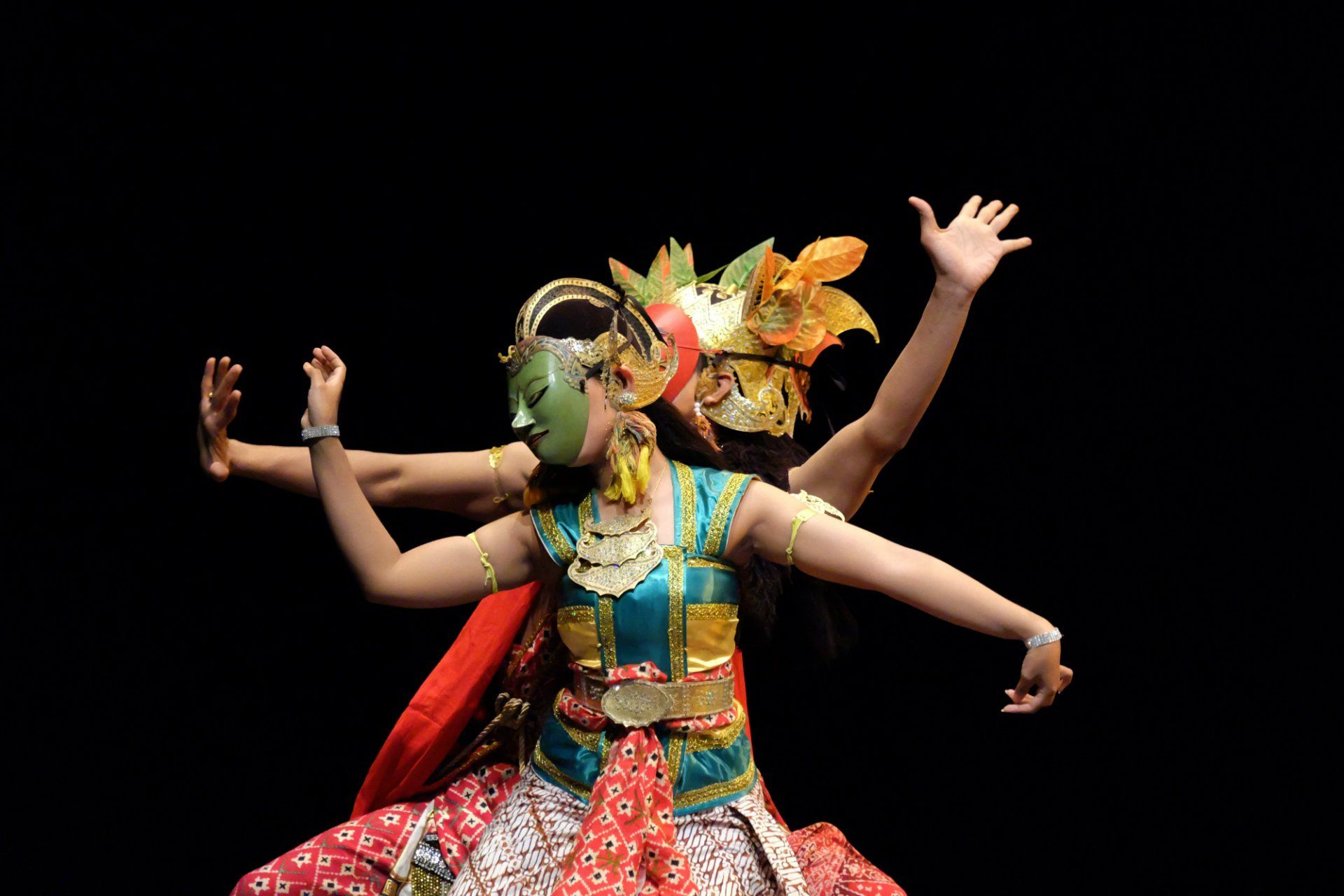
© Fehmiu Roffytavare / Shutterstock
Covered by forest, studded by volcanos, fringed by beautiful beaches and clear water, there is no shortage of things to do in Java. Attracting climbers, trekkers and birdwatchers, plus divers and those searching for cool, clean mountain air, Java is an island where you can stay in a traditional village one day and be sucked into the great cultural cities of Yogyakarta and Solo the next. Here's what to do in Java:
Kota is the heart of the old 17th-century Dutch settlement at Batavia, originally a walled town modelled on Amsterdam. Most of Old Batavia was demolished at the beginning of the 19th century, but the town square area survived and has been restored and renamed Taman Fatahillah (Fatahillah Square). Adjacent colonial buildings have been converted into museums, and the whole neighbourhood has been considerably gentrified in recent years.
The main square of Jakarta bustles at weekends with street entertainers, old-fashioned bicycle rentals, artists and food vendors. The best thing to do here is to visit the museums that line the square: Museum Sejarah Jakarta (Jakarta History Museum), which houses memorabilia from the colonial period; the Museum Wayang (Puppet Museum), home to many puppets and masks including rare buffalo hide shadow puppets; and the Museum Seni Rupa (Fine Arts Museum), which features paintings and sculptures by modern Indonesian artists.

Fatahillah Square in Jakarta © Shutterstock
Any visit to Jakarta should begins at the top of the Monas (National Monument). A 137-metre-tall marble obelisk is set in the centre of Lapangan Merdeka (Freedom Square). There is an observation deck at the top surmounted by a 14-metre bronze flame sheathed in 33kg of gold symbolising the spirit of freedom.
It was commissioned by Sukarno and completed in 1961 – a combination Olympic Flame-Washington Monument with the phallic overtones of an ancient Hindu-Javanese lingga. The museum in the basement contains 12 dioramas depicting historical scenes from a nationalistic viewpoint. A high-speed elevator rises to the observation deck, where on a clear day there is a fabulous 360-degree view of Jakarta.

Monas, Jakarta, Indonesia © Shutterstock
Java’s sandy and secluded west coast beaches to the west of Jakarta are sublime. There are numerous pretty bays and low-key developments mainly aimed at weekend trippers from nearby cities. At Anyer, several large resorts grace the coastline surrounding Dutch-built Anyer Lighthouse. Continuing 6km (3.5 miles) south is Karang Bolong, a huge rock forming a natural archway to the sea.
Its pleasant beach is a popular weekend swimming spot for Jakartans. Another 10km (6 miles) south is Carita, with sandy beaches situated in a lovely cove. Here there is beachside accommodation, a marina and sailing, jet-skiing, diving and snorkelling. In addition to sun, sea, sand and solitude, this palm-fringed coast has stunning sunset views of Anak Krakatau (Child of Krakatau).
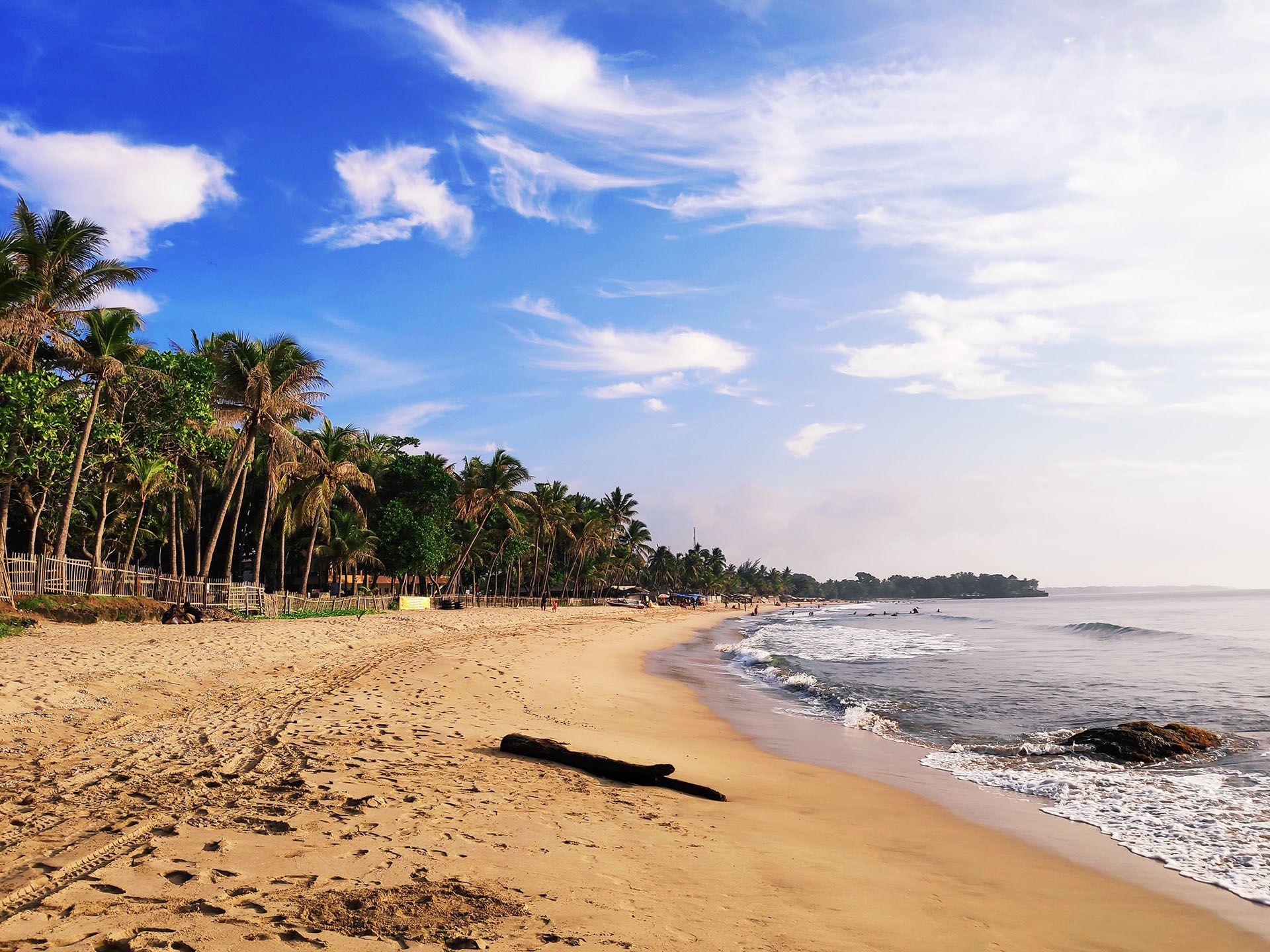
Anyer Beach, West Java - Indonesia © Shutterstock
The original Krakatau volcano achieved lasting infamy in 1883, when it erupted with cataclysmic force, ripping out a huge chunk of the earth’s crust to form a monstrous 40-sq km (16-sq mile) submarine caldera. The sea rushed in, and tidal waves up to 30 metres (100ft) high swept the coast, claiming many lives. Today, all that remains of the mighty volcano are Sertung, Panjang and Rakata at its crater rim. In the decades that followed, undersea eruptions continued and a new peak emerged from the sea in 1927: Anak Krakatau.
An active volcano, Anak Krakatau erupted in 2018. Its caldera partially collapsed, triggering a tsunami. Boats go from Carita for day trips out to the volcano. When conditions allow, it is still possible to land on Anak Krakatau, but since the 2018 eruption, most tours stick to nearby Rakata Island, a surviving fragment of the original.

Krakatau, Indonesia © Shutterstock
Located south of Carita on the southwest tip of Java, the 420-sq km (260-sq mile) Ujung Kulon National Park is the last refuge for the highly endangered and seldom-sighted Javan rhino. The park also has other interesting animals, including leopards, macaques, leaf monkeys, mousedeer, crocodiles and banteng (wild oxen). Much of the area is dense lowland rainforest, open woodlands, and wetlands – excellent for birdwatching – with beaches in the north and south.
Peucang island, north of the mainland portion of the park, has basic bungalows and a restaurant, where deer, monkeys and monitor lizards are a common sight. About 10 minutes by boat from Peucang is Cidaon, the grazing ground for banteng and Javan peacocks. The highlight of the park experience is a canoe ride starting from Handeuleum island up the Cigenter River, where scientists monitor the Javan rhino activity.

Rhinoceros in their habitat in Indonesia © Shutterstock
Sprawling Yogyakarta (Yogya or Jogja) is situated at the very core of an ancient region known as Mataram, site of the first great Central Javanese kingdoms. Today, it is Jogja’s cultural attractions that travellers come to see – ancient temples, palaces, batik, gamelan, dances and wayang puppet performances. Growing in popularity are nature-related activities.
Don't miss the Keraton (Sultan’s Palace), a two-centuries-old palace complex that stands at the heart of the city. The ‘Golden Pavilion’ or Bangsal Kencana (central throne hall) is its most striking feature – a pendopo or open pavilion consisting of an ornate sloping roof supported at the centre by four massive wooden columns.

Yogyakarta Palace or Keraton Yogyakarta Hadiningrat, a palace complex in the city of Yogyakarta © Shutterstock
You could easily spend half a day at the Borobudur Unesco World Heritage Site. Allow yourself a minimum of two hours to tour the candi (temple). This huge mandala, the world’s largest Buddhist monument, was built sometime during the relatively short Sailendra dynasty between AD 778 and AD 856 – 300 years before Angkor Wat and 200 years before Notre-Dame.
Yet, within little more than a century of its completion, Borobudur and the other structures in Central Java were mysteriously abandoned as the focus of Javanese royal power shifted to the east.

Borobudur, Yogyakarta, Indonesia © Shutterstock
If you are visiting Borobudur, make sure to put Prambanan on you to-do list as well. Visiting Prambanan in Java is a truly mesmerizing experience. As one of the largest Hindu temples in Southeast Asia, it is a testament to the impressive architecture and intricate artwork of the region.
The towering spires and intricate carvings of the temple complex are a sight to behold, and exploring the various shrines and courtyards is a great way to immerse oneself in the rich history and culture of the area.
Additionally, the temple's location amidst lush greenery and serene ponds creates a peaceful atmosphere that is perfect for meditation or simply relaxing and taking in the beauty of the surroundings. Whether you're a history buff, architecture enthusiast, or simply looking for a unique and awe-inspiring destination to visit, Prambanan is an absolute must-see.
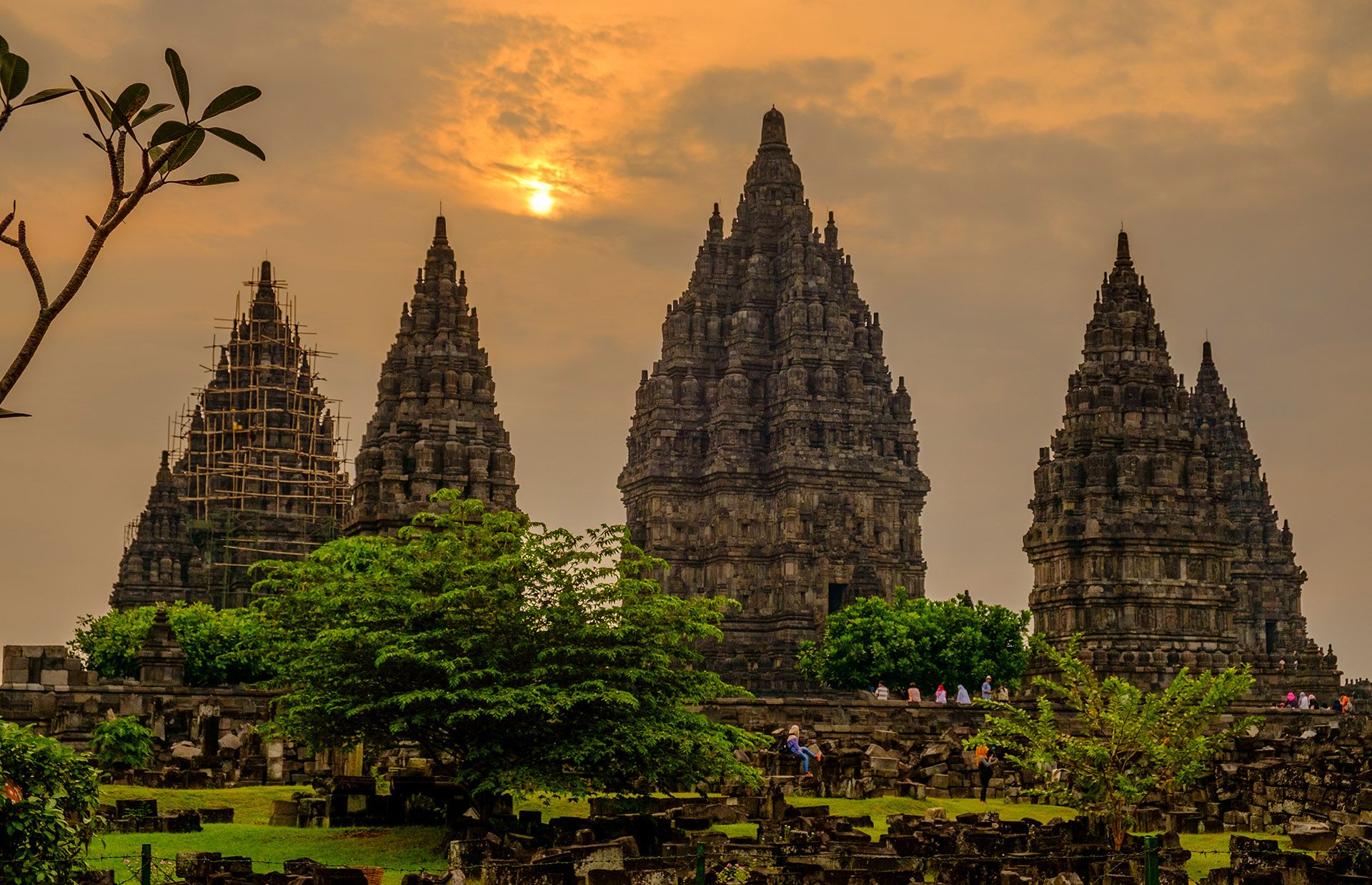
Prambanan, Yogyakarta, Indonesia © Shutterstock
East Java’s provincial capital, Surabaya, is known as the ‘City of Heroes’ because of the momentous first battle of the Indonesian revolution which took place here in November 1945. The most interesting areas of the city are the old Arab, Chinese and colonial neighbourhoods in the north. The richly atmospheric Arab quarter, generally known simply as Ampel, is centred on the mosque and tomb of Sunan Ampel, one of the legendary saints said to have spread Islam in Java. The mosque compound is approached via a narrow, covered bazaar with a decidedly Middle Eastern ambiance.
Further south, amidst crumbling colonial-era shop-houses, the vast Pasar Pabean market is a warren of stalls and alleys. From late afternoon until early morning the western part of the market turns into an emporium for freshly caught fish. Beyond the market, the original Chinese quarter begins, home to old temples such as Hong Tik Hian and Surabaya’s oldest Chinese shrine, the 18th-century Hok An Kiong. The temple’s central deity is the goddess Ma Co, the protector of waterlogged sailors.
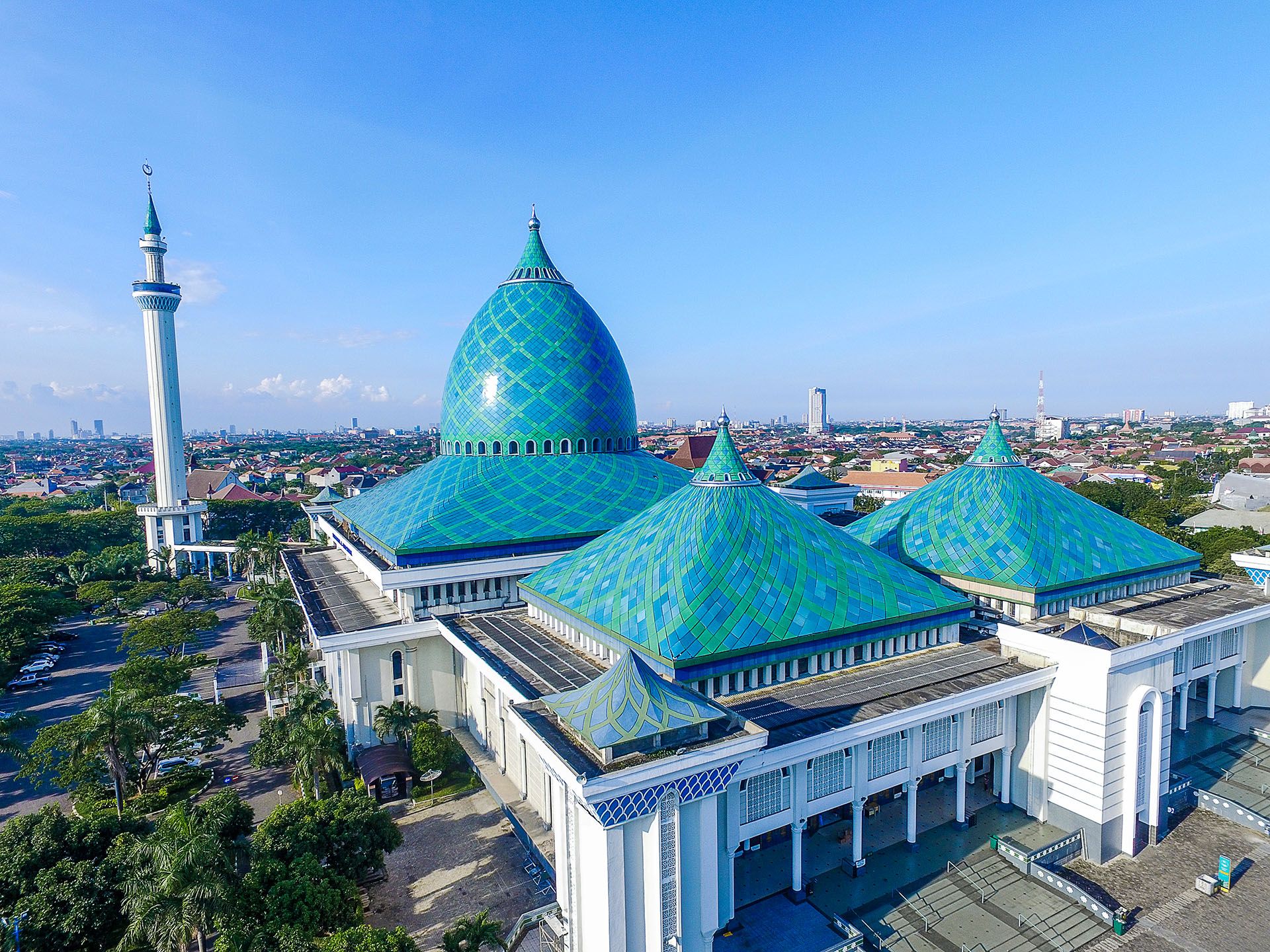
Aerial Al Akbar Mosque Surabaya, is a Located in Surabaya © Shutterstock
Accessible via the longest in Southeast Asia, Madura is overwhelmingly rural and deeply traditional island. The far east, centred on the sleepy former royal town of Sumenep, is particularly attractive. Sumenep is home to a small palace museum, some interesting royal tombs, and a strikingly attractive mosque, Masjid Agung.
There are some fine beaches and unspoilt countryside nearby. Madura is also famed for its traditional bull racing (karapan sapi). According to the Madurese, the races began long ago when plough team was pitted against plough team over the length of a rice field. Today’s racing bulls are never used for ploughing, but are specially bred; they represent a considerable source of local and regional pride.
Tretes is a delightful mountain resort offering fresh air, cool nights and superb scenery. Walk or ride on horseback in the morning to one of three valley waterfalls in the vicinity. Though busy at weekends, it is peaceful mid-week, and makes a good base for exploring the beautiful local countryside, which has rice-terrace scenery every bit as extensive, and often more impressive, than that of Bali.
More active souls will want to hike up Gunung Arjuna (3,339 metres) through lush montane casuarina forests, or across the Lalijiwa plateau along a well-worn path to neighbouring Gunung Welirang, where villagers collect sulphur from hissing fumaroles. The area is also studded with ancient monuments, beginning with Candi Jawi, just by the main road 7km (4 miles) below Tretes. This slender Hindu-Buddhist shrine was completed around 1300, and is one of several funerary temples dedicated to King Kertanegara of the Singasari dynasty.
There are so many high-quality and cool places to stay in Java that if you've somehow managed to book a flea-ridden bed in a basic room, you're doing it wrong. Jakarta and Yogyakarta have a wealth of places to stay, from cheapo hostels to gated resorts with more stars than the Milky Way. In rural areas, homestays and guesthouses are great ways to meet locals, whilst along the coast, beachside huts and mega-resorts give visitors plenty of choice, too.
Packed with a great choice of accomodation, Jakarta is likely to be most travellers first point of arrival. Rooms here are cheap, there's a good selection of higher-end resorts and luxury stays. There are some really cheap hostels as well.
With Yogyakarta and Solo being such cultural and historical hot spots, there are loads of great heritage hotels in both cities. Ambarawa and the Karimunjawa Islands both have some amazing, blissed-out escapes and out in the sticks, you'll likely to find real, authentic guesthouses and homestays.
You've come for the beaches, right? Fortunately, there are plenty of sand-side stays: bungalows, huts, homestays and guesthouses. This region also has a surprising amount of chic boltholes that cost very little.
There is plenty of choice in West Java, from international chain hotels to cheap hostels and more boutique accommodation as well. If you're heading out into the countryside, look for hidden resorts and thatched bungalows.
Browse the best places to stay in Java.
From street food vendors to swish fine dining, Java has some incredible places to eat that run. The staple for the majority of Indonesians is rice. Coconut milk and hot chilli peppers are popular cooking ingredients island-wide. Dishes range from very spicy meat, fish and vegetables, such as the Padang food found everywhere in restaurants called rumah makan Padang, to those that are quite sweet. Almost all come with steamed white rice (nasi puti). The most popular dishes among visitors are nasi goreng (fried rice), mie goring (fried noodles), sate or satay (grilled meat or chicken on skewers) and gado-gado (cold, steamed vegetables served with a peanut sauce). Nasi campur is a good choice for travellers because it is a complete meal, including rice, a vegetable and a piece of meat, usually chicken.
Chinese restaurants are found in almost every town and offer less spicy food and vegetarian dishes. In the main tourist centres, resorts and big cities like Jakarta, restaurants will cater for visitors and serve a wide variety of cuisines, including Western. All cities have American fast-food outlets such as KFC (Kentucky Fried Chicken), and larger ones have McDonald’s and Pizza Hut.
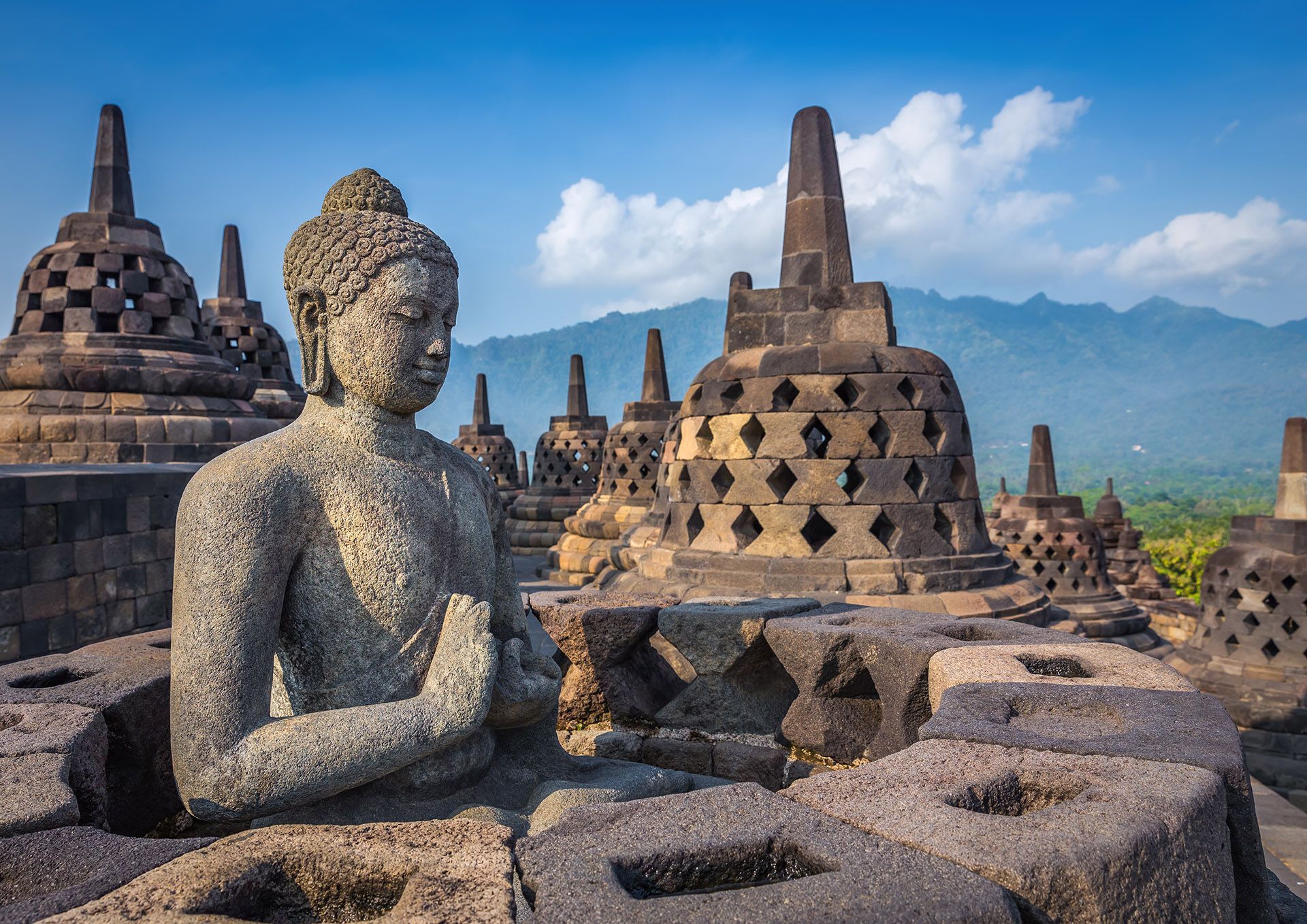
© Bule Sky Studio/Shutterstock
It is easy to get to Java, especially as Jakarta has the island's biggest airport. There are domestic ferries serving the island as well, but only cruise ships travel here internationally.
The vast majority of long-haul international flights arrive either at the huge and recently upgraded sukarno-hatta international airport (also spelled Soekarno- Hatta), 20km (13 miles) west of Jakarta on Java. The city is well-served with long-haul flights and is a major domestic hub. There are more limited international connections to Bandung, Yogyakarta (Jogja), Surakarta (Solo) and Surabaya, all of which also have regular connections from Jakarta.
The cost of internal flights in Indonesia has increased considerably in recent years, while short-haul regional links remain highly competitive. It may be cheaper to use Kuala Lumpur or Singapore as your long-haul destination, and then to book a flight with a regional budget airline such as AirAsia directly to your final destination, rather than heading to Jakarta or Bali and travelling onwards from there.
Scheduled international passenger ferries to Indonesia are a thing of the past, thanks to cheap air travel. The old links between Malaysia and Indonesia have mostly been discontinued. The archipelago is regularly visited by cruise ships, however. Cruise operators often offer fly-cruise arrangements that allow you to fly to Bali and other ports, then catch a ship on the way home, or vice versa.
PELNI, the state-owned shipping company, serves several ports on Java. The busy vehicle links between major islands are mainly operated by ASDP. In bad weather, especially during the rainy season (Oct–Apr), the seas can be quite rough, particularly between Sumatra and Java, and all ferry runs may be cancelled. Enquire at the local ticketing office if the weather looks ominous.
Learn more about how to get to Indonesia.
Whilst some of Java's highlights can be visited in a week, to really do the island justice you will need two weeks here. Jakarta alone will keep you busy for three or four days and that's before you even set off for the cultural cousins of Yogyakarta or Solo. Throw in the great monuments of Borobudur and Prambanan, boat trips to Anak Krakatau, hikes up Mount Bromo and a trip to Thousand Islands (Pulau Serib) to just relax and you've already got a fortnight right there. The best advice would be to pick one or two areas of the island and stick to the best things to do there.
Looking for inspiration for your trip? Talk to our Indonesia travel experts.
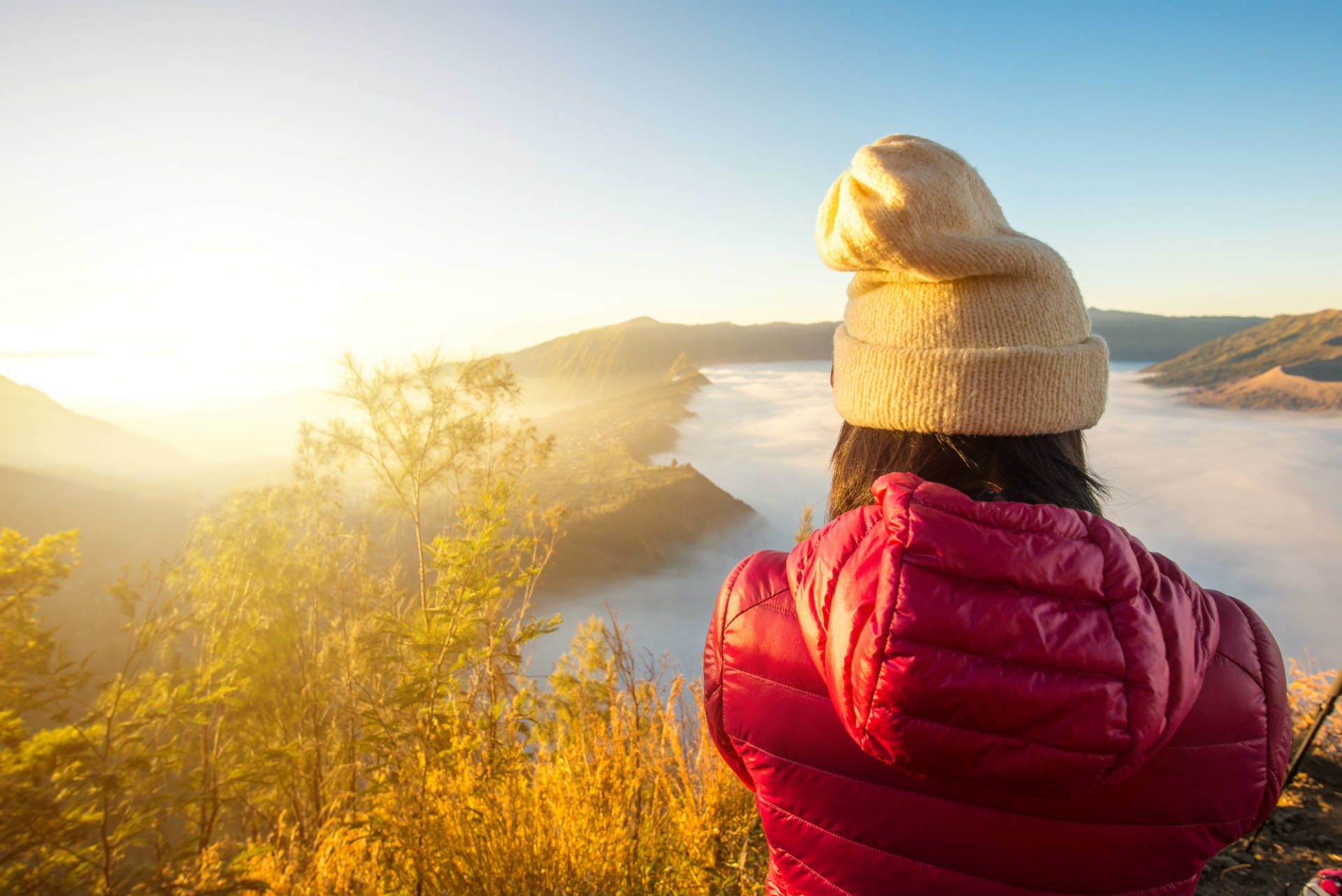
© Boyloso/ Shutterstock
There are plenty of good ways to get around in Java with planes doing the heavy lifting across large distances. Buses are great for intercity travel but can get caught up in traffic jams in larger cities like Jakarta. Trains are good too but you will need to book ahead.
The cost of internal flights in Indonesia has increased considerably in recent years, while short-haul regional links remain highly competitive. It may be cheaper to use Kuala Lumpur or Singapore as your long-haul destination, and then to book a flight with a regional budget airline such as AirAsia directly to your final destination, rather than heading to Jakarta or Bali and travelling onwards from there.
Intercity buses in Java are generally comfortable modern coaches with air-conditioning, and increasingly often with Wi-Fi. Smaller, less comfortable buses provide links to smaller towns and rural areas. These days, many Indonesians prefer to book intercity transport on ‘travel’; these are typically air-con minibuses or large cars, which run door-to-door. They are slightly more expensive than long-distance buses, but much more convenient (though in big cities they can spend a long time picking up passengers from scattered locations). Most hotels or travel agents should be able to make a booking for you.
Java’s train network, running from east to west, offers services to all its major cities. In the east, it connects with ferries to Bali, and in the west, with ferries to Sumatra. More comfortable than buses, Java's rail network is affordable and efficient. Most lines are single-track, so it's not uncommon for trains to sell out weeks in advance. Book ahead online.
Car rental in Java is uncommon but the hire of a car and driver can be arranged through most hotels or guesthouses. Negotiate better rates if you are booking a vehicle for a week or longer, but note that you are responsible for the driver’s food and lodging, and for the petrol.
Java has a tropical climate with two distinct seasons: the wet season (October to March) and the dry season (April to September). The best time to visit Java is June when the weather is excellent and the holiday crowds that arrive in July and August are yet to fill the hotels. Due to flooding and landslide risks, hiking and climbing should only be undertaken during the dry season.
There are several great festivals on Java, including Independence Day (17 August) and Labuhan in Jogja (25 August), where there is a procession to Parangkusumo beach to give offerings to Nyi Roro Kidul, Queen of the Southern Sea, to thank her for successful harvests and to ask blessings for the coming season. In East Java, the Madura Bull Races take place from September to November. In Pamekasan in October, the Sapi Sono Festival names the most ‘beautiful’ buffalo in the region.
Find out more about the best time to visit Indonesia.
Use Rough Guides' trusted partners for great rates
written by
Rough Guides Editors
updated 13.06.2024